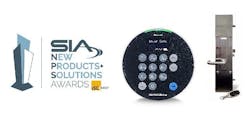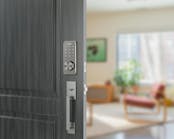10 Years Ago
Like this April, April 2015 was our annual Know Your Distributors issue. In addition to our distributor chart, we profiled distributors Security Lock Distributors (now SECLOCK) and Accredited Lock Supply. Both touted electronic access control as their fastest growing sector. In his SHDA report 10 years ago, IDN’s Arnie Goldman wrote about locksmith Mark Baldino’s uphill battle against shady competitors with deep pockets and Internet search engines. A decade later, this remains an issue for our industry. Another distributor-themed article looked at the training opportunities offered to locksmith customers. In article Making Connections, Tim O’Leary explained how Molex Low Voltage Wire Connectors simplify electronic access control installations. O’Leary also recommended useful tools for electronic access control installations and repairs. An article on delayed egress looked at code requirements and advised always getting the local authority having jurisdiction’s approval.
20 Years Ago
Know Your Distributor was the primary topic of the April 2005 Locksmith Ledger and Tom Gillespie had some very good reasons for supporting your favorite locksmith distributor. Rod Oden shared some interesting tips and tricks for master keying high-rise buildings. Marks USA introduced their new IQB biometric lockset. Tim O’Leary asked the question, "Will Biometrics Replace Keys?" Ten years later the answer is still not apparent. A special report from Security Hardware Distributors Association (SHDA) outlined the reasons to support SHDA members. Jerry Levine provided servicing procedures for Kwikset Maximum Security lever locks. Gale Johnson reviewed the Arrow Designer handleset and deadbolt locks. Levine also showed how to change the combination on a Codelocks 400 series auxiliary lock. A demonstration of reading wafer locks key cuts with a Peterson Wafer GM was shown. Tiny fit keys to a 10-cut CSS column ignition lock using an A-1 pick set. This lock can be found on light duty trucks and GM SUV models. Anita Bishop, Allstate Insurance, provided advice for choosing commercial auto insurance.
Upgrading to Electronic Safelocks
This article from 10 years ago provides valuable reference information on safelocks.
As technology advances and new laws and policies stress the importance of secure record storage with audit trails, safe and safe lock manufacturers are migrating to electronic safe locks.
For commercial, institutional and government requirements, electronic safe locks offer advanced security features including biometrics, multiple users with unique security privileges, time lock, time delay, programmable events and one-time use combinations. To ensure higher levels of performance, electronic safe lock manufacturers test lock performance to meet requirements including stress, vibration, shock, electrical discharge and electromagnetic pulse. An Underwriters Laboratories Type 1 Listing certifies that the lock meets the appropriate standards of security and construction.
Many electronic safe lock bodies have the same mounting footprint as standard mechanical safe locks, allowing for easy retrofit without modification. Electronic safe locks have no wheels; they are universal for RH (Right Hand), LH (Left Hand), VU (Vertically Up) and VD (Vertically Down) mounting. However, electronic safe lock body thicknesses vary by design and are sometimes different from the thicknesses of the mechanical safe lock being replaced. Some secondary mechanisms (i.e. relocks) in safes may require modification to accommodate the smaller body thickness of an electronic safe lock.
Going beyond the basic, commercial electronic safe locks features and functionality can include multiple users, single/dual control, time delay, time lock, duress, alarm interface, etc. An audit lock is a commercial electronic safe lock that has multi-level users, audit trail with time and date stamp and other features to increase the level of accountability. Most audit locks operate with a computer interface. The AMSEC ESLAudit Lock is designed for one- or two-door safes. Standard features include 40 users with unique security privileges and authority levels, 2,000 audit records, USB interface, time delay, time lock, PIN code and/or Dallas Key, holiday scheduling and graphics display.
Specialized electronic safe locks include biometric locks with fingerprint readers, redundant locks and GSA approved locks.
A redundant safe lock is a mechanical lock that has electronics either piggybacked onto or built into the case. The redundant lock can be operated as an electronic safe lock by entering the code into a keypad/input device or as a mechanical lock by dialing the combination. A redundant safe lock can be operated by a single input device equipped with an electronic keypad and a mechanical dial or a keypad and a mechanical dial.
Read the full article at www.locksmithledger.com/12050394.






